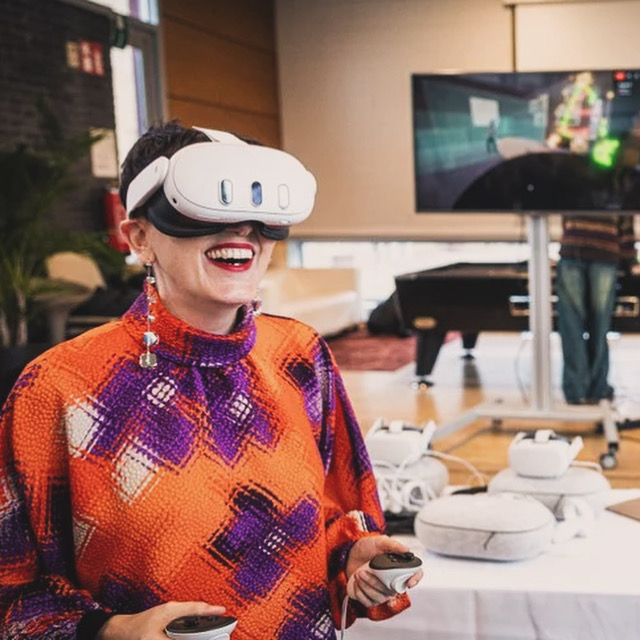Our research project aims to bring AI into the artist’s practice by developing open-source tools and methodologies that make the field more accessible and transparent. The project asks how AI can become a trusted partner in the creative process, both during creation and execution. We explore how AI understands the materiality of body, space and time. Through carefully self-assembled datasets and an intuitive visual understanding of algorithms, we can avoid the bias inherent in large-scale models and take ownership of our own “small AI.”
With Dr. Frederik De Bleser and Lieven Menschaert
- UX-XR: artistic developments of human-technology-interaction in ‘the metaverse’ (2022 – 2023)
Since the early days of computing and the internet, extensive attention has been paid to the experience of the user (UX: user experience) and user environment (UI: user interface). This is a necessary part of ‘human-machine-interaction’ (HMI) and/or ‘human-technology-interaction’ (HTI), allowing the user to engage (interact) with the technology they are using.
We have also recently seen this issue recurring more and more within the digital arts, where the use of and interaction with the technology is a primary stumbling block in the perception of an audience towards a digital artwork.
This young art form also brings with it a new audience: young generations growing up with technology and the so-called metaverse. They usually know very intuitively how to interact with the most common UIs. But today’s generations who experience art and culture often do not have this background. This is precisely why it is important to develop the UX in such an intuitive way, so that the artistic experience can be fully experienced as soon as an audience enters an artistic portal.
- Sense of Wonder (2020 – 2021)
With Sense of Wonder, MAXlab and CREATIE aim to jointly develop an artistic framework to enable long-term innovative digital experiences at the intersection between the physical and virtual worlds.
- #DramaQueen (2019 – 2021)
Composer Jason Eckardt wrote his first mono drama for flutist in 2015, The Silenced. The score is not only a musical challenge – it also requires a profound emotional narrative, dramatic elements, a basic choreography and scenography.
Within this research, i developed the virtual mono drama, where the parameters mentioned above, function as the motor of the virtual and visual experience.
Read more about the artistic creation of Empty Mind.
- Tomorrow’s music in practice today (2017 – 2019)
It was my ambition to develop and document a general performance practice method for contemporary music, in order to make contemporary music scores accessible and understandable for every student at the conservatory in a pragmatic way.
The results of my doctoral research from 2016 at the University of California, San Diego, where I developed a specific performance practice method for the solo works for flute by ‘New Complexity’-composer Brian Ferneyhough, function as a starting point for this research.
For more info: Tomorrow’s Music in Practice Today
Brian Ferneyhough wrote six challenging and complex pieces for flute solo: Cassandra’s Dream Song (1970), Unity Capsule (1975-1976), Superscriptio (1981), Carceri d’Invenzione IIb (1985-1986), Mnemosyne (1986) and Sisyphus Redux (2011). Besides understanding Ferneyhough’s compositional vocabulary, every piece also requires a different practicing method. This dissertation is a musical, interpretational, analytical and motivating guide for flutists who desire playing Ferneyhough’s oeuvre. After many years of practicing and researching these six pieces, I developed a performance practice method that may help aspiring flutists in the future while discovering this rich oeuvre.
This performance practice method includes mythological, philosophical, mathematical and musical analyses, as well as a technical explanation and instrumental tricks that will enlarge the performer’s creativity and freedom in interpreting this complex oeuvre.
In this lecture I’m describing a non-gender related interpretation of Cassandra’s Dream Song. This ground-breaking piece by Brian Ferneyhough has been an interesting discussion topic for decades now. In the 70’s, 80’s and early 90’s, the contemporary music scene was dominated by male performers. This trend is also obvious in the early interpretations of the piece: a mathematical and analytically ‘correct’ interpretation was to be aimed for.
In the 90’s, female performers claimed their own voice and the piece became the subject of a feminist movement.
Anno 2015, I think it is time for a more contemporary approach of the piece and music in general. I like to think of the Cassandra Complex as an ever changing global concept, adapted in many research fields.
A complete list of my academic output can be found here.
Follow me on Academia.edu.
